
VOL. II NO. 23 REG NO. L5015 DELHI, THURSDAY FEBRUARY 17, 1944
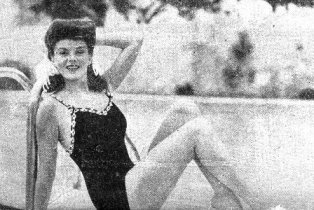 Marguerite Chapman, it says here, is now appearing in My Kingdom for a Cook. Candidly, the Roundup
staff doesn't give an anna if she can cook or not. Decorate a diving board nicely, does she not?
Marguerite Chapman, it says here, is now appearing in My Kingdom for a Cook. Candidly, the Roundup
staff doesn't give an anna if she can cook or not. Decorate a diving board nicely, does she not?
|
BURMA - The double-pronged offensive of the American-trained Chinese troops screening the construction of the Ledo Road pushed slowly but inexorably southward down the jungled Hukawng and Dalu Valleys this week, using as springboards the recently-taken villages of Taipha Ga and Taro.
Early week communiqu s announced that the Japanese had been cleared from the north bank of the Chindwin River west of Taipha Ga, while subsequent reports disclosed bitter jungle clashes west, northeast and southwest of that village.
West of Taipha Ga, one report told of two pockets of enemy resistance being cleared near the junction of the Chindwin and Taraung River; another of an action in which considerable casualties were inflicted and prisoners taken on the Chindwin's tortuous south bank.
In an ambush made eight miles northeast of Taipha Ga, the Chinese killed 32 Japanese, including two officers. Contact is being maintained in this area, as well as five miles farther south, and in one place a unit of Japanese is reported surrounded.
The Chinese advance south-eastward from Taipha Ga is continuing with only token resistance, although the Japs have stiffened their opposition farther south.
In the Dalu Valley, the first of four reports announced that the Japs were driven from a position eight miles west of Taro. Next, an enemy pocket was cleared near Taro, a slight advance made east of taro and progress reported in the face of bitter opposition northeast of Taro.
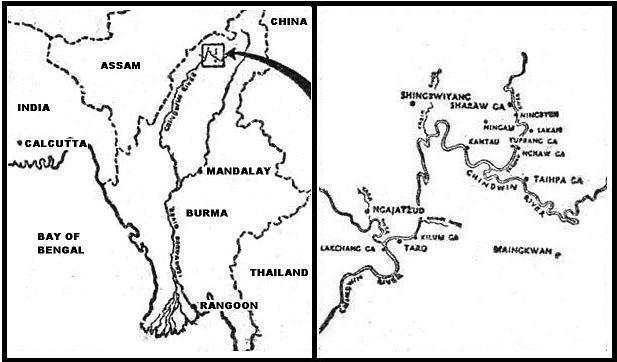
|
CBI To Receive Super-Planes
A lightning-fast triple play, Nimitz to Stilwell to Stratemeyer, was executed this week.
It was initiated by Admiral Chester W. Nimitz, C-in-C, U.S. Pacific Fleet. In discussing the Marshalls invasion, Nimitz disclosed that the ultimate goal of that action is to establish bases on the Chinese mainland from which to attack Japan.
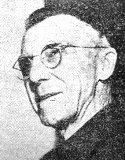
|
The ball was then shot to Lt. Gen. Joseph W. Stilwell, CBI Theater commander, "To accomplish such a mission," declared Stilwell, "the naval action must be supported heavily by an aggressive Allied land and air offensive projected from the interior. This we intend to do in spite of the existing blockade."
How this offensive from inside China will be sustained by vitally-needed supplies was explained by Stilwell. "Air transport in this Theater has set historic records, but far greater tonnage totals must be achieved than our present operations permit," he admitted. Then came his punch line: "To accomplish this end, we will have the largest and newest cargo carriers available and, in anticipation of such aircraft, every facility and accommodation is being prepared."
Maj. Gen. George E. Stratemeyer, commander of all USAAF in India under Stilwell, completed the triple play by amplifying Uncle Joe's promise of a new type of transport plane. "The plan for the giant transports is all set," he announced. "In fact, it is far beyond the planning stage. These big, new air transports will fly from India to China over new routes, carrying far larger payloads at higher speed and equipped with enough armament to defend themselves adequately in the air. American plants are turning out these super-transports right now for the Army Air Forces and we are getting ready to use them this spring as a special adjunct to the Air Transport Command's famous operations over the Hump."
Stratemeyer paused for a breath, "Thousands of our Indian and Chinese allies," he continued, " are working night and day to prepare the additional ground facilities required for these giant cargo ships. Their longer range, higher speed, added ceiling and huge payload will enable us to fly important war supplies into certain areas of China which we have been unable to serve efficiently with air transport in the past."
|
Officers and enlisted men of the Air Transport Command, India-China Wing, today were wearing a blue silk ribbon surrounded by a gold frame over their right breast pockets, emblematic of the citation received from President Roosevelt last month for the unit's outstanding accomplishments.
It is the Distinguished Unit Badge, the first of which was presented to Brig. Gen. Earl S. Hoag, CG of the ATC, India-China Wing, by Maj. Gen. George E. Stratemeyer, commanding general of all USAAF in India and the Eastern Air Command, in a ceremony in Delhi early this week.
Hoag read to assembled troops a letter which Stratemeyer had written Feb. 3, immediately after he had surveyed the record of increased tonnage which the wing's airplanes hauled from India to China over the Hump during January.
Stratemeyer's letter announced that the wing would soon receive new giant transport planes and that "our Chinese allies are now working night and day preparing in their country the necessary facilities so that we can in the immediate future continue operation on an increased scale."
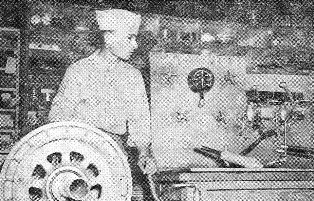 Sgt. Frank Zikes operates his homemade hydraulic test stand, born out of the scrap pile through his ingenuity.
Sgt. Frank Zikes operates his homemade hydraulic test stand, born out of the scrap pile through his ingenuity.
|
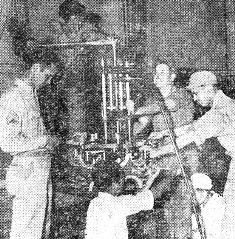 Supplementing ASC troops, Chinese, Burmese and Indian workers are often trained to help in the various shops.
Supplementing ASC troops, Chinese, Burmese and Indian workers are often trained to help in the various shops.
|
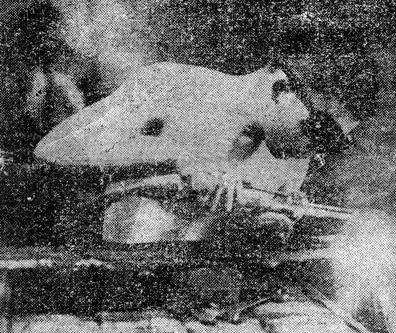 T/Sgt. William Bishop, a welder in civilian life, continues to use his torch to give the Japs a "hot foot."
T/Sgt. William Bishop, a welder in civilian life, continues to use his torch to give the Japs a "hot foot."
|
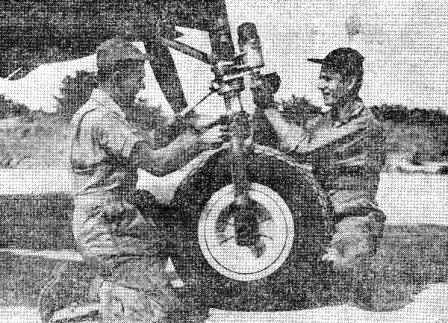 Particular pains are taken with the landing gear, for the ASC doesn't want a beautiful mission marred by a faulty
landing. S/Sgt. Robert Dawes and Sgt. Joe Shimeta do the adjusting.
Particular pains are taken with the landing gear, for the ASC doesn't want a beautiful mission marred by a faulty
landing. S/Sgt. Robert Dawes and Sgt. Joe Shimeta do the adjusting.
|
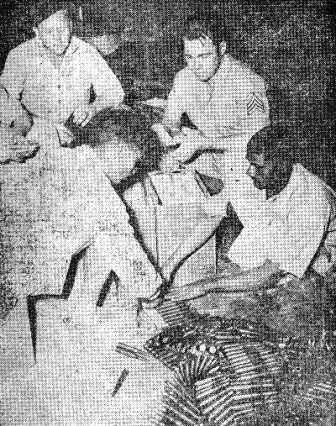 "Greetings" to our little yellow cousins are stacked neatly into ammunition belts at an ASC base to be sent to
a forward unit.
"Greetings" to our little yellow cousins are stacked neatly into ammunition belts at an ASC base to be sent to
a forward unit.
|
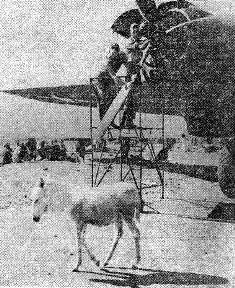 The camera blends the old and the new as two prop specialists bend to their task on a "big un."
The camera blends the old and the new as two prop specialists bend to their task on a "big un."
|
APPRECIATED PARTNER IN CBI
You'll seldom see their names distinguished by printers' ink. They serve in silence at obscure bases. They don't share the glory and glitter of the Air Force which bombs the enemy and knocks down his planes, but they make the missions possible. They're the lads of the China-Burma-India Air Service Command, under Brig. Gen. Robert C. Oliver.
Most of them are trained at Air Corps schools in Shangri-La for specific tasks on aircraft or maintenance. Many of them are skilled workers from civilian trades who fitted immediately into the ACS pattern.
Sparks of ingenuity flare frequently among them. They know that the enemy won't wait, so they don't wait for equipment that may never come from the States. At one base there are six test-boards for hydraulic and electrical parts that have been born in fertile minds and constructed from the scrap pile.
There's not an item that the Air Force needs that the ASC isn't able to supply for immediate use. If it isn't to be had, it's devised, but it's gotten. It is a silent partner of the men who wear silver wings, and there's many an airmen who has thanked an ASC ground crew for his life.
YOUTHFUL VETERAN OF CBI PRESENTED DSC AT CEREMONY
CBI AIR FORCES TRAINING COMMAND - The Distinguished Service Cross and the Purple Heart were presented here to Lt. Frederick F. Ploetz by Brig. Gen. Julian B. Haddon in a retreat review composed of American and Chinese personnel of the CBI Air Forces Training Command.
Ploetz, of Sheboygan, Wis., won both awards while on duty with a fighter group in the Solomon Islands and Guadalcanal. He won the Purple Heart in February, 1943, and the DSC in June, 1943.
Maj. William B. McGehee, of the CBI Chinese-American Operational Training Unit, read the citation. This is how Ploetz used a handkerchief to save his life, shoot down a Jap Zero and return safely to his base:
"As pilot of a P-40, an integral member of an escort covering bombers on a strike mission against enemy shipping, during an attempted interception by enemy Zero fighters and float biplanes, Lt. Ploetz received a severe shrapnel wound in his left arm on his first attack. His airplane was hit in the wing and cockpit, and forced to a level of 1,000 feet. He recovered, tied a handkerchief around his arm, rejoined his flight at 8,000 feet and in spite of injuries received and intense pain, he continued the battle for 15 minutes and succeeded in shooting down one of the enemy craft. Lt. Ploetz then brought his plane back safely to its base with the rest of the flight."
SO THAT YOU DON'T HAVE TO WALK BACK AND ASK FOR REPLACEMENT
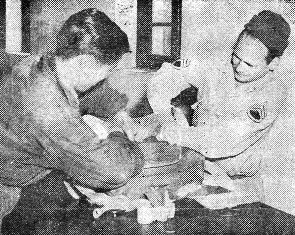 S/Sgt. Acil L. Petty packs a parachute, aided by Chih Jong Ho, his Chinese assistant.
S/Sgt. Acil L. Petty packs a parachute, aided by Chih Jong Ho, his Chinese assistant.
|
14th A. F. HQ. - We were standing beneath the high, vaulted ceiling of a dimly-lit room, the beamed loft of which was ringed with tall, slender, white-robed forms which swayed gently to and fro in rhythm like emaciated figures in some sacrificial rite. The air throbbed with a high-pitched whine.
"This," said S/Sgt. Acil L. Petty, of Delta, Utah, "is the parachute drying room. Every 'chute we have in stock and every one on our fighters, bombers and transport planes is turned in on an average of 30 days for airing and repacking."
Petty is in charge of the parachute department. With his staff of four parachute packers - two G.I.'s and two Chinese - he is responsible for every one of the canvas-covered packs of silk and nylon that enters his department. To them belongs the credit for the fact that there's never been a parachute failure in this area among combat crews or among the men of the Air Transport Command.
Petty pointed out the source of the whine that dinned in our ears. Two big heater blowers were circulating warm, dry air through the 'chutes dangling from hooks in the ceiling 40 feet above our heads.
"Moisture," Petty explained, "is one of the things we have to keep an eye on. When 'chutes are carried into high altitudes and then back downstairs, moisture sometimes condenses in the packs. They then mildew. And if they aren't aired out and repacked at regular intervals, someone's going to jerk a rip-cord and find that either it won't open or that it's rotted full of holes."
I remarked about the strong odor of moth-balls that filled the room and Petty shook out a few yards of a partially folded 'chute. A shower of snowy flakes fell to the floor.
"Another precaution," he said. "We gotta keep the moths out. It would be a lot worse finding they'd eaten holes in your parachute than finding they'd eaten the seat out of your best Sunday pants."
"I think I got my biggest kick out of a full colonel who came in once to have a 'chute repacked," declared Petty. "He was with the ground forces, but had been on a detail that took him across country every few days. He came back for the pack the next day. He started for the door and then turned around and looked sort of puzzled. 'Say,' he said to me, 'there's something I wanted to ask about this thing. If I ever have to use it, does it just open or is there some gadget that I have to pull or something?' Brother can you tie that one?"
Pilots Save Xmas Gifts For G.I.'s
APO 627 - Thanks to the fact that Lts. R. E. Thomas and C. A. Gibson believed in the spirit of Santa Claus, G.I.'s at this post received their Christmas presents from home.
The two officers - Thomas at the controls and Gibson as co-pilot - were flying a load of Christmas presents into APO 627 when the plane struck a mountain top. Damage was considerable, with the left landing gear destroyed, left engine instruments knocked out of commission and the stabilizer and right elevator jammed at an approximately neutral position.
The pilot managed to climb to 11,000 feet and ordered Crew Chief Clark and Radioman Singelton to bail out.
Thomas and Gibson stuck to the ship. They managed a crash landing without any additional damage to the plane or the cargo.
After the landing, the pilot was asked why they hadn't jumped. He simply replied that they would have, except that "they had mail aboard."
THREE NEW SHEETS REGALE CBI G.I.'S
"It's a conspiracy," muttered Ye Ed, "to put the Roundup out of business."
He had received notice that three newspapers have been added to the rapidly-growing CBI list - Tiger Rag at APO 492 (Bombay), Slip Stream at the Third Air Depot and Victory Light at SOS Base Section No. 1.
The most pretentious of these papers is the Tiger Rag, edited by Sgt. Ed Belford, now blossomed into eight pages of machine-set type, plus some very sharp drawings by staff artist T/5 L. H. Wicksten.
Slip Stream, edited by Sgt. James G. Doyle and Pfc. Ed Frey, and Victory Light, edited by S/Sgt. Harry A. Skvirsky, are both mimeographed sheets.
All feature lively, gossipy local news and, as far as the Roundup is concerned, they are strictly teekah.
|

|
14TH A.F. HQ - There were many stars on the field in more ways than one, here last week when the Softball League opened. A-1 boasted the most stars of the "general" variety with its battery of Maj. Gen. Claire L. Chennault pitching, and Brig. Gen. Edgar L. Glenn catching, but other teams had their stars, too.
Outcome of the first round games saw A-3 make the most of seven errors committed behind pitcher Chennault to conquer the A-1 club, 8-6, when Lee's stop at short killed a last-frame rally.
Communications rallied in the sixth to score six runs and beat A-2 by an 11-10 count, as Bird led the way with four straight safeties. AG was most impressive in blasting 24th SCU, 10-3, in a tilt that featured Schlapprazzi's homer with the bases loaded.
Meadows, of A-1, also slammed a homer in hitting three for four. Fred Thomsen had a perfect day at bat, three for three.
'ALL FORCES HOUR' IN INDIA
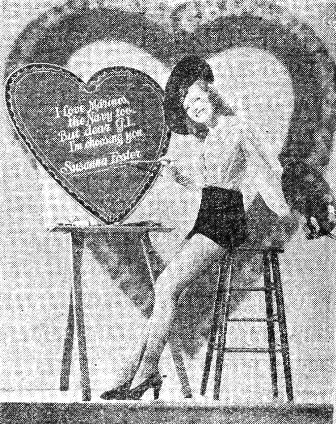 Here's a poignant reminder that this is St. Valentine's Day week.
I Love Marines, the Navy too. But dear G.I., I'm choosing you. - Susanna Foster.
Well, we can dream can't we?
Here's a poignant reminder that this is St. Valentine's Day week.
I Love Marines, the Navy too. But dear G.I., I'm choosing you. - Susanna Foster.
Well, we can dream can't we?
|
RADIO PROGRAM TO START MONDAY;
TOP-FLIGHT ENTERTAINMENT SLATED
The "All Forces Hour," a new series of radio broadcasts especially dedicated to troops in the Assam and Burma forward areas, will formally begin next Monday from New Delhi, under the auspices of a joint committee of officers of the India Command and the Southeast Asia Command. The program will be heard seven nights a week from 6:30 to 7:30.
Designed to brighten the lives of the boys farthest forward in the weeds with the top-flight programs of America and England, the new broadcast will be beamed to Assam and Burma, but some reception will be possible in other sectors. It will be broadcast on 41.15 meters, 7,290 megacycles, utilizing a 7.5 kilowatt transmitter.
Preceding the formal inauguration of the series proper, five test transmissions were begun yesterday and will run through Sunday, featuring outstanding "name" productions. Those in charge request field units to tune in and forward reception reports, in order to assist the broadcasters in attaining peak reception efficiency. The address to which reports should be sent is: Broadcast Section A.G. 17(e), GHQ, New Delhi.
The first week's program indicates that a real treat will be in store for G.I. listeners. Among other features, the Jack Benny Hour, the Charlie McCarthy program and the Telephone Hour, with Grace Moore, will be presented, as well as the music of Andre Kostalanetz, Tommy Dorsey, Harry James and Alvino Rey, programs of concert recordings and news broadcasts.
Because the broadcasts are designed for all forces, there will be an equal balance of programs of special interest to Americans and British, in addition to broadcasts of general interest.
Genius
G.I. REMBRANDTS ON THE BEAM
APO 467 (Sookerating, India) - G.I.'s here are waiting for modern science to get off the anna and perfect a three-dimensional projection outfit that breathes a little life and warmth into the pictures it projects.

|
This lovely dream was inspired here recently when someone hit on the bright idea of borrowing an opaque projector from a traveling training unit to project on the walls of the day room pictures of luscious Varga, Petty, Moran and other lovelies. To make the effect permanent, local Rembrandts then sketched around the outlines of the projected pictures and later filled in the - ah - details.
"If they were only real!" sigh morale-starved G.I. art critics as they study the life-like murals resulting from this novel wedding of art and science.
NEW P-38 FLOWN IN WAR THEATERS
WASHINGTON - The War Department this week announced that a new and improved long-ranged P-38 fighter is now being used in war theaters.
The improvements include a longer range, a 30 percent increase in horsepower, a materially increased rate of climb at all altitudes, a radical rate of climb above 30,000 feet and greater level flying speed at high altitudes.
The ceiling for the fighter has been raised to well over 40,000 feet.
|
Claimed By CBI Crew
AIR TRANSPORT COMMAND, INDIA - A G.I. world record for a complete engine change on an Army C-47 cargo plane with only field equipment is claimed for eight mechanics at this base who did the complete job in one hour, 23 minutes.
The previous Theater record was three hours and 25 minutes, established in Assam.
The men who did the job were S/Sgts. John T. Morrison and Henry L. Wagner; Sgt. James W. Murrell; Cpls. Charles M. Hough, George B. Cohen, John R. Patterson and George L. Muzzy and Pfc. John D. Brackett. Morrison was in charge of the detail.
Col. K. C. McGregor, commanding officer of the Western Section, ICW-ATC, and Col. James W. Gurr, commanding officer of this station, were the ranking officers who witnessed the change. The test was the result of a barracks opinion made by the enlisted men in a conversation with Capt. Charles Orne, Engineering Officer for this station.
14TH RIPS NIP SHIPS; SINKS 22,400 TONS
14th A. F. HQ. - In one of the most active weeks in some time, the 14th Air Force hit Japanese shipping, installations, barracks, rail yards and airdromes in occupied China, French Indo-China, Burma and Hainan Island. Total results showed that 22,400 tons of shipping were sunk, 15 enemy planes destroyed, 10 probably destroyed and 3,600 tons of shipping damaged. Seven American planes were lost, but three of the pilots were saved.
French Indo-China was the hardest hit, bombers and fighters visiting this area six times within the week. In these attacks, bridges, power plants, shipping, radio stations, barracks and installations were destroyed or damaged.
HEAVY JAP LOSS
Highlighting the week's operations were the attacks carried out on Feb, 12-13. On the 12th, fighters intercepted 25 Japanese planes which were on their way to attack a forward base. Seven Jap aircraft were shot out of the sky and seven more were probably destroyed. The next day, Liberators dropped 63 tons of bombs on the railroad yards and repair shops at Vinh, French Indo-China, while fighter-bombers hit Japanese barracks and airdrome installations at Phu Tho, French Indo-China. One hangar blew up and many fires were started. Some 35 freight cars in the vicinity of Yen Bay and Buo Ha were strafed.
Mitchells on a sea sweep of the Tong King Gulf, sank a 750-ton vessel, which broke in half when beached, and a 2,700-ton steamer. Hainan Island was then bombed, railroad trackage and oil dumps being damaged.
Mitchells of the Chinese-American Wing smashed a six-ship convoy off Foochow, China, on the same day, sinking three totaling 13,800 tons and severely damaging one 1,200-ton transport. At the same time, American aircraft sank one 1,200-ton freighter and damaged two 1,200-ton freighters.
NEW TOJOS DOWNED
On Feb. 11 and 12, fighters and bombers roamed wide over occupied China, Western Yunnan and French Indo-China, shooting down five Jap fighters, including new Tojos. On the 11th, Mitchells of the Chinese-American Wing, on a sea sweep off the East China coast, sank a 5,000-ton transport and also probably sank two small tenders totaling 1,600 tons.
Earlier in the week, Mitchells bombed Japanese installations at Wanting on the Yunnan-Burma border and hit three Japanese-occupied villages. Other Mitchells hit at Hainan Island. Planes of the Chinese-American Wing at the same time probably destroyed two enemy fighters. In Central China, fighters shot down two enemy craft and probably three more. After leaving their target they were intercepted by three Jap fighters, one of which was probably destroyed and another damaged.
During a daylight attack on Feb. 11, P-38's dive-bombed and destroyed the railroad bridge at Sheklung, northeast of Canton. Railroad bridges at nearby Shektan were strafed, and two trains destroyed.
|
SURPRISED JAPS SNAFU
BROWN BROTHERS SEEM TO BELIEVE
WHAT'S NOT HEARD CAN'T HURT
CHINA AIR BASE - Our little playmates of the China theater of operations may die with fanatical bravery when holed up in a foxhole, but they're not so sharp when taken by surprise in an unexpected development.
This, at least, is the opinion of a Mitchell bomber crew which recently returned from a low-level sweep against Jap installations in southern China, with two examples to relate of Jap reaction to a sudden attack.
NO HEAR, NO HURT
During one raid, the bombers made a sudden attack on Jap barracks, and approximately 100 Japs were noted running for cover. But on the second attack, only one little yellow man remained to witness further destruction. The Jap was standing, facing the oncoming bomber, with a finger in each ear, evidently operating on the theory that what you can't hear won't hurt you.
he was very, very wrong. When last seen he was literally mounting heavenward on the wings of a demolition bomb. He may not have heard the explosion, but the results were quite positive, notwithstanding.
NEW RETREAT RECORD
One the same sweep, the same Mitchell assisted the Jap in setting a world record for the fastest retreat ceremony ever staged by their army or any other. A Jap cantonment was in the act of beginning the sunset ceremony for the banner of the rising sun when the Mitchell hove in sight. The Japs finished the ceremony so rapidly that, instead of just lowering the flag, they tore down the flagpole as well. The entire formation, the bomber crew estimates, was begun and finished in less than 30 seconds.
And, in their opinion, it will be quite some time before any banner at all flies over that particular spot - unless the Japs begin flying their flag at the bottom of a bomb crater.
WILSON'S DAUGHTER DECEASED IN INDIA
Margaret Woodrow Wilson, eldest of the late President Wilson's daughters, died this week in India. Miss Wilson was a member of the religious group headed by Sir Auribindo and has been at Pondicherry for four years. She was 57.
Small World
INCREDIBLE STORY OF BUDDIES IN INDIA
INDIA BASE UNIT - Here's a story to end all "it's a small world" stories - and it would be incredible if it weren't well-known that truth is stranger than fiction.
Chapter One: Boris Norman and Sam Toper were born next door to each other in Czarist Russia, and were inseparable boyhood chums. Came the Revoloooshun, and their families fled to China, but were separated in the hurried exodus.
Chapter Two: Boris' folks settle in Harbin, Manchuria, and for five years he often wondered what had become of Sam. He found out one day when he literally bumped into another youngster on the street. You've guessed it, it was Sam.

|
Chapter Three: Boris, a first-rate pianist and accordionist, eventually said goodbye to Sam and left Harbin to play in a Shanghai night spot. Five years later they ran into each other again, by accident, in Shanghai.
Chapter Four: Boris, tiring of Shanghai, started out on a globe-trotting expedition. Tokyo, Hong Kong, Calcutta and Honolulu claimed his temporary attention as he worked his way along in musical jobs. He finally landed in, of all places, Brooklyn. And there whom do you think he ran into in a movie line? Okay, it was Sam.
Chapter Five: Weeks passed, and diverse interests drew the boys apart. In September of 1942, Boris' friends and neighbors looked on him with an approving eye, and Uncle Sam suggested he might like it at Camp Upton. Comes a USO dance. Comes also the ubiquitous Sam, who had been greeted by the President only a day after his buddy.
To make an incredible story short, both were then assigned to the same hospital unit and shipped off to India, where their knowledge of Oriental languages makes them invaluable as interpreters.
What's that? You don't believe it? Neither would anyone else, if it weren't right there in black and white in their service records.
10th Air Force Pounds Enemy On Natal Week
The second anniversary of the 10th Air Force was properly celebrated this week in the combat operations of the Eastern Air Command over Burma and Siam.
In the north, U.S. fighter planes of the Tactical Air Force bombed and strafed targets on a large scale, striking at troops and supply concentrations and lines of communications in the south, all types of planes combined their operations with those of the RAF in attacks on airfields, rail towns, ports and enemy stores areas. Most of the missions were in direct support of the Chinese troops in the Hukawng Valley and the British in the Arakan battle zone.
On Feb. 12 and 13, three formations of U.S. fighters and fighter-bombers attacked motor convoys on the Myitkyina-Sumprabum road, in northern Burma; large numbers of motor vehicles were destroyed or damaged and fires were started over a wide area. Other formations struck at bivouac and supply areas in the Kamaing and Walawbum areas, destroying a radio installation near Kamaing and causing heavy damage to a supply area at a road and railway junction north of Samaw.
RIVER STEAMER HIT
In a sweep between Mandalay and Shwebo on the 11th, a large river steamer was set afire in the Irrawaddy. Other formations started large fires in bivouac and supply dump areas at Pyindaw and Samaw. Targets were also hit by medium bombers of the Strategic Air Force in the northern rail cities of Katha and Bhamo.
On Feb. 8, U.S. medium and fighter-bombers attacked a camp near Mogaung, starting many fires and knocking out a gun emplacement. Another formation tackled a camp south of Kumnyen, and mediums heavily damaged two bridges southwest of Shwebo.
U.S. fighter-bombers attacked Wuntho, southwest of Katha, on Feb. 6. One big warehouse exploded with a large red flash when hit by heavy bombs. Several other warehouses were destroyed.
Heho airdrome, in the south, received its third heavy raid in recent days when a strong force of U.S. heavy bombers of the Strategic Air Force blasted its runways and revetment areas on the night of Feb. 13-14.
BANGKOK RAIDED
RAF and U.S. heavies raided Bangkok on the night of Feb. 10-11. The majority of bursts were in the target area and large fires were started. U.S. heavies also attacked Akyab and Prome. The following night, RAF mediums hit supply dumps at Prome; smoke from the fires started rose to 6,000 feet. On Feb. 8, RAF fighters had heavily damaged locomotives and rolling stock, as well as 50 river craft, in the Prome area. The previous day, RAF mediums scored hits on the runways of Toungoo airfield, causing several explosions and fires visible for 50 miles.
From the Mayu Peninsula and the Arakan front to the Upper Chindwin, numerous sorties were made by RAF and U.S. aircraft ranging from fighters to medium bombers. The RAF put up a good show; they shot down four Jap fighters in aerial encounters, probably destroyed four more and damaged 25 others. Another enemy fighter was downed by ground batteries. Only one Allied plane was lost.
In a raid near Mawlaik (Upper Chindwin) a fire started by RAF dive-bombers was intensified by fighters which dropped their overload fuel tanks into the blaze.
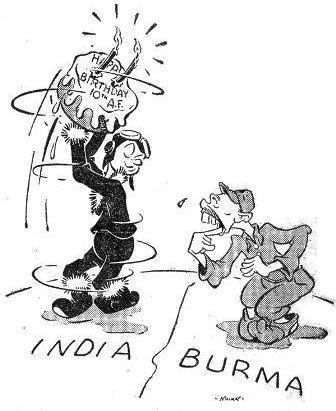
|
10TH AIR FORCE TWO YEARS OLD ON FEB. 12
If the Roundup had some candles, it would have had a birthday cake this week, if it had the cake. For, dear friends and gentle readers, this week an important unit of the CBI Theater celebrated its second birthday.
But, lacking the cake, which it would proudly have presented to the men in question, the Roundup must do the best it can with a verbal salute to the 10th Air Force, two years old on Feb. 12.
The words for such a salute aren't easy to find - for there is too much to say and too little space in which to say it. A detailed account of what the 10th has done and is doing would fill volumes, and still leave a lot out.
And all the words in the dictionary wouldn't tell the human side of the 10th Air Force's record . . . the feelings of a bomber crew in a monsoon gale with six Zeros on its tail . . . those of a fighter pilot out of gas over matted jungles or jagged peaks . . . the bone-deep fatigue of ground crews fighting to get a wounded plane back into the air on time . . . the silence in a lot of hearts when a plane filled with buddies goes out into the blue and never returns.
So we won't try to say here, the things that really should be said. Instead, we'll content ourselves with a brief summary of the bald facts, which are good enough to stand by themselves in any man's language.
The 10th was a war baby, born only two months and five days after the sneak Jap attack on Pearl Harbor. Like any newborn babe, it wasn't much in the beginning - only 10 officers and a handful of enlisted men, under command of Maj. Gen. Lewis H. Brereton, when it was activated at Patterson Field, O. And it wasn't much more than that a month later when it arrived in India; just a wing and a prayer, minus the wing.
But it grew fast. Part of its growth, paradoxically enough, came as a result of the early defeats which America faced immediately after our part of the war started. The 10th's first striking force consisted of veterans of the Philippines who were diverted from Java on the fall of that island. Others joined them from Pearl Harbor. Later, veterans of the Coral Sea, and some members of Jimmy Doolittle's Tokyo fliers and former AVG's swelled the ranks. To these were added outfits fresh from the States, eager for a crack at the Japs.
Originally commanded by Brereton, who left to head the Ninth Air Force at El Alamein and later, the 10th was subsequently commanded by Brig. Gen. Earl L. Niaden, Maj. Gen. Clayton L. Bissell, and is now headed by Maj. Gen. Howard C. Davidson, himself a veteran of Pearl Harbor. The recent incorporation into the Eastern Air Command, under Maj. Gen. George E. Stratemeyer, has further improved its opportunity to cooperate with the RAF in an all-out job of making the Japs miserable in Burma, but has not caused it to lose its organizational identity nor its pride in the record it has piled up.
When it first arrived, the Jap was virtually unopposed in the air over Burma. Now, with the RAF, the 10th has gained clear-cut supremacy over the enemy and has carried the air war deep into enemy territory. In addition, it has piled up the following records: Longest combat mission ever flown (Bangkok); longest over-water mission (Car Nicobar); longest average flying mission of any theater; longest average number of combat hours for flying personnel, as well as many other outstanding individual and unit achievements.
This will go on until the war ends and the Jap is finally brought to bay in the flaming ruins of Tokyo. Until that day, the 10th, as always, will be in there doing its part. We don't wish them many happy birthdays, but we do wish them happy birthdays and happy landings - until there's no longer any reason to fly the Far Eastern skies and the 10th, as well as everybody else, can shut up shop and go home.
The C.B.I. Roundup is a weekly newspaper published by and for the men of the United States Army Forces in China, Burma, and India, from news and pictures supplied by staff members, soldier correspondents, the United Press, and the Army News Service. The Roundup is published Friday of each week and is printed by The Statesman in New Delhi, India. Editorial matter should be sent directly to Lt. Floyd Walter, Rear Echelon Hq., U.S.A.F., C.B.I., New Delhi, and should arrive not later than Monday in order to make that week's issue. Pictures must arrive by Sunday and must be negatives or enlargements. Stories should contain full name and organization of sender.

FEBRUARY 17, 1944
Original issue from the collection of C.B.I. Roundup Correpondent Al Sager, shared by CBI veteran Dave Dale.
Copyright © 2006 Carl Warren Weidenburner
TOP OF PAGE PRINT THIS PAGE ABOUT THIS PAGE SEND COMMENTS
PREVIOUS ISSUE CLOSE THIS WINDOW NEXT ISSUE
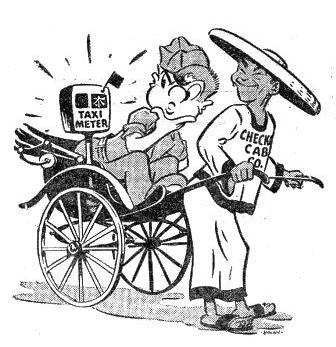
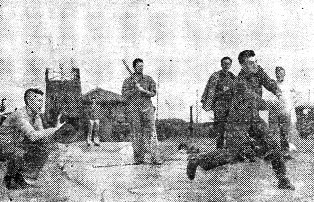 Brig. Gen. Edgar L. Glenn has his mitt in position to catch one of Maj. Gen. Claire L. Chennault's tosses, in the
opening game of the 14th Air Force Softball League. Lt. S. P. Tuzzeo swings viciously. Awaiting
his turn
to face the general is Sgt. Robert E. Convery, while Pvt. Karl Loeber keeps score and Lt. James Dunn observes.
Brig. Gen. Edgar L. Glenn has his mitt in position to catch one of Maj. Gen. Claire L. Chennault's tosses, in the
opening game of the 14th Air Force Softball League. Lt. S. P. Tuzzeo swings viciously. Awaiting
his turn
to face the general is Sgt. Robert E. Convery, while Pvt. Karl Loeber keeps score and Lt. James Dunn observes.
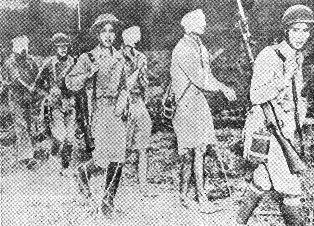 Here's pictorial proof of the combat efficiency of the American-trained Chinese troops now advancing against the
Japanese in the Hukawng and Dalu Valleys of northern Burma. Jap prisoners, blindfolded, are led to Intelligence for
interrogation. Note the U.S. combat helmets.
Here's pictorial proof of the combat efficiency of the American-trained Chinese troops now advancing against the
Japanese in the Hukawng and Dalu Valleys of northern Burma. Jap prisoners, blindfolded, are led to Intelligence for
interrogation. Note the U.S. combat helmets.
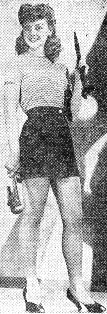 What's all this talk about drafting American labor into war plants? Spot a few war workers like this around
at key points and who wouldn't be first in line to grab off the job at the bench next to her?
What's all this talk about drafting American labor into war plants? Spot a few war workers like this around
at key points and who wouldn't be first in line to grab off the job at the bench next to her?